remove seats FORD MUSTANG 2003 4.G Owners Manual
[x] Cancel search | Manufacturer: FORD, Model Year: 2003, Model line: MUSTANG, Model: FORD MUSTANG 2003 4.GPages: 256, PDF Size: 2.4 MB
Page 105 of 256
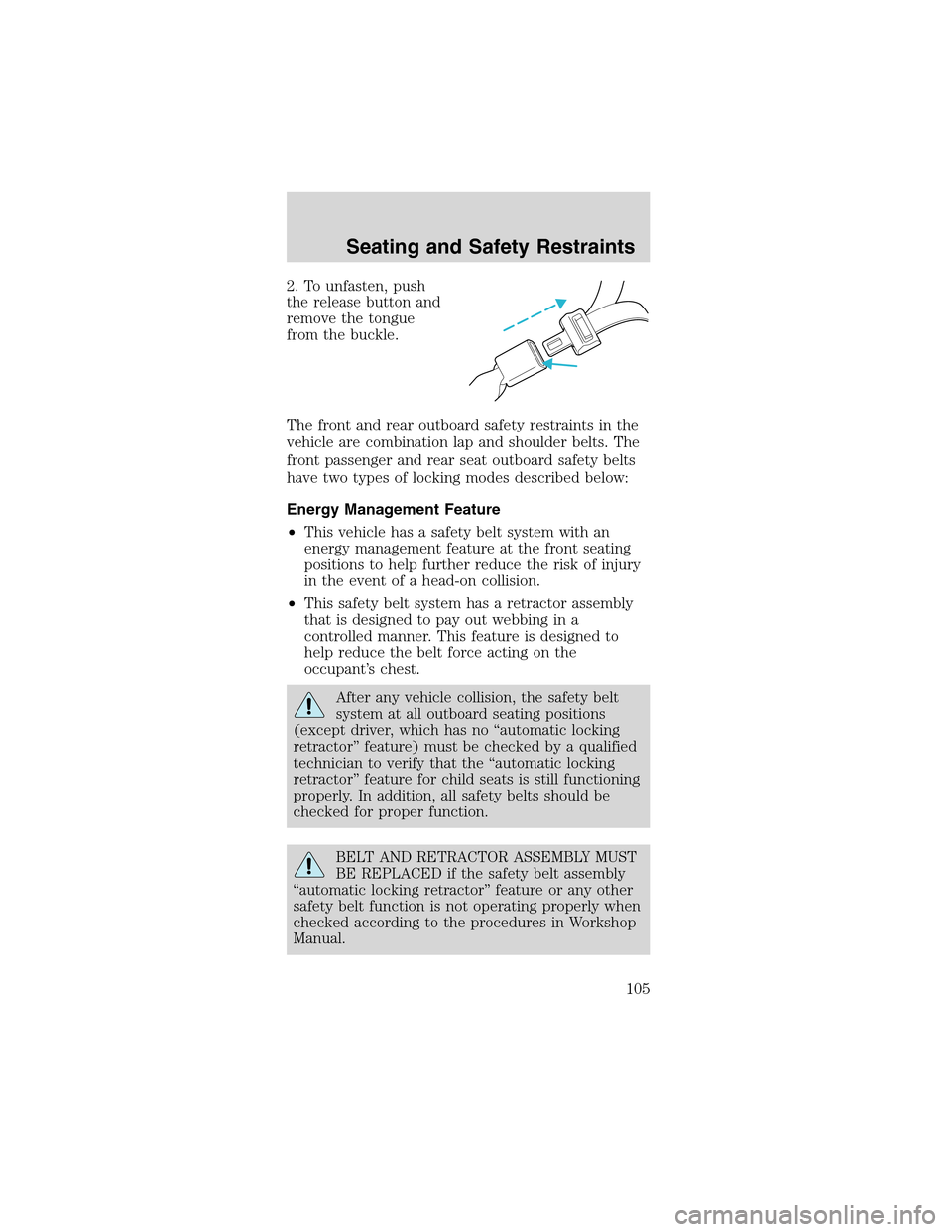
2. To unfasten, push
the release button and
remove the tongue
from the buckle.
The front and rear outboard safety restraints in the
vehicle are combination lap and shoulder belts. The
front passenger and rear seat outboard safety belts
have two types of locking modes described below:
Energy Management Feature
•This vehicle has a safety belt system with an
energy management feature at the front seating
positions to help further reduce the risk of injury
in the event of a head-on collision.
•This safety belt system has a retractor assembly
that is designed to pay out webbing in a
controlled manner. This feature is designed to
help reduce the belt force acting on the
occupant’s chest.
After any vehicle collision, the safety belt
system at all outboard seating positions
(except driver, which has no“automatic locking
retractor”feature) must be checked by a qualified
technician to verify that the“automatic locking
retractor”feature for child seats is still functioning
properly. In addition, all safety belts should be
checked for proper function.
BELT AND RETRACTOR ASSEMBLY MUST
BE REPLACED if the safety belt assembly
“automatic locking retractor”feature or any other
safety belt function is not operating properly when
checked according to the procedures in Workshop
Manual.
Seating and Safety Restraints
105
Page 106 of 256
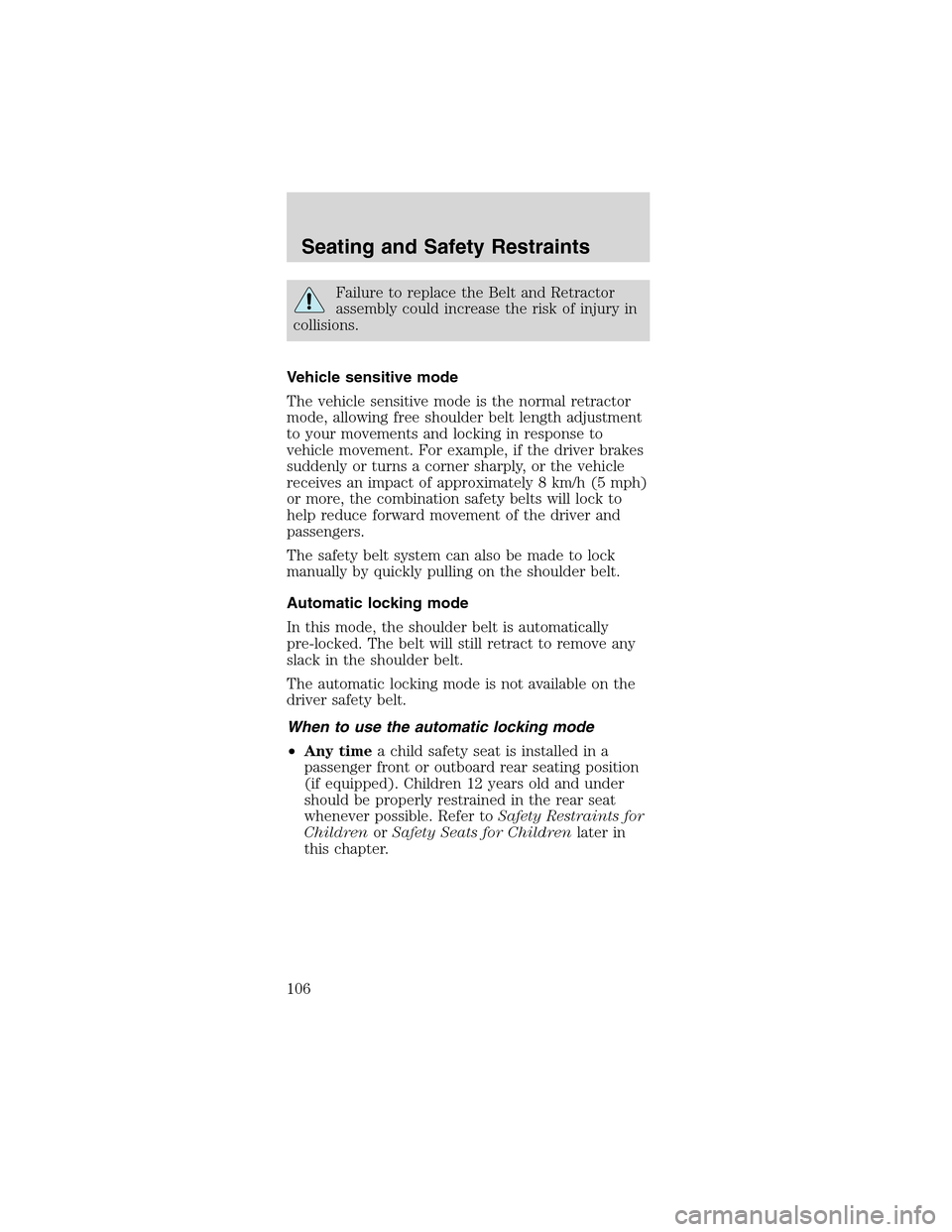
Failure to replace the Belt and Retractor
assembly could increase the risk of injury in
collisions.
Vehicle sensitive mode
The vehicle sensitive mode is the normal retractor
mode, allowing free shoulder belt length adjustment
to your movements and locking in response to
vehicle movement. For example, if the driver brakes
suddenly or turns a corner sharply, or the vehicle
receives an impact of approximately 8 km/h (5 mph)
or more, the combination safety belts will lock to
help reduce forward movement of the driver and
passengers.
The safety belt system can also be made to lock
manually by quickly pulling on the shoulder belt.
Automatic locking mode
In this mode, the shoulder belt is automatically
pre-locked. The belt will still retract to remove any
slack in the shoulder belt.
The automatic locking mode is not available on the
driver safety belt.
When to use the automatic locking mode
•Any timea child safety seat is installed in a
passenger front or outboard rear seating position
(if equipped). Children 12 years old and under
should be properly restrained in the rear seat
whenever possible. Refer toSafety Restraints for
ChildrenorSafety Seats for Childrenlater in
this chapter.
Seating and Safety Restraints
106
Page 122 of 256
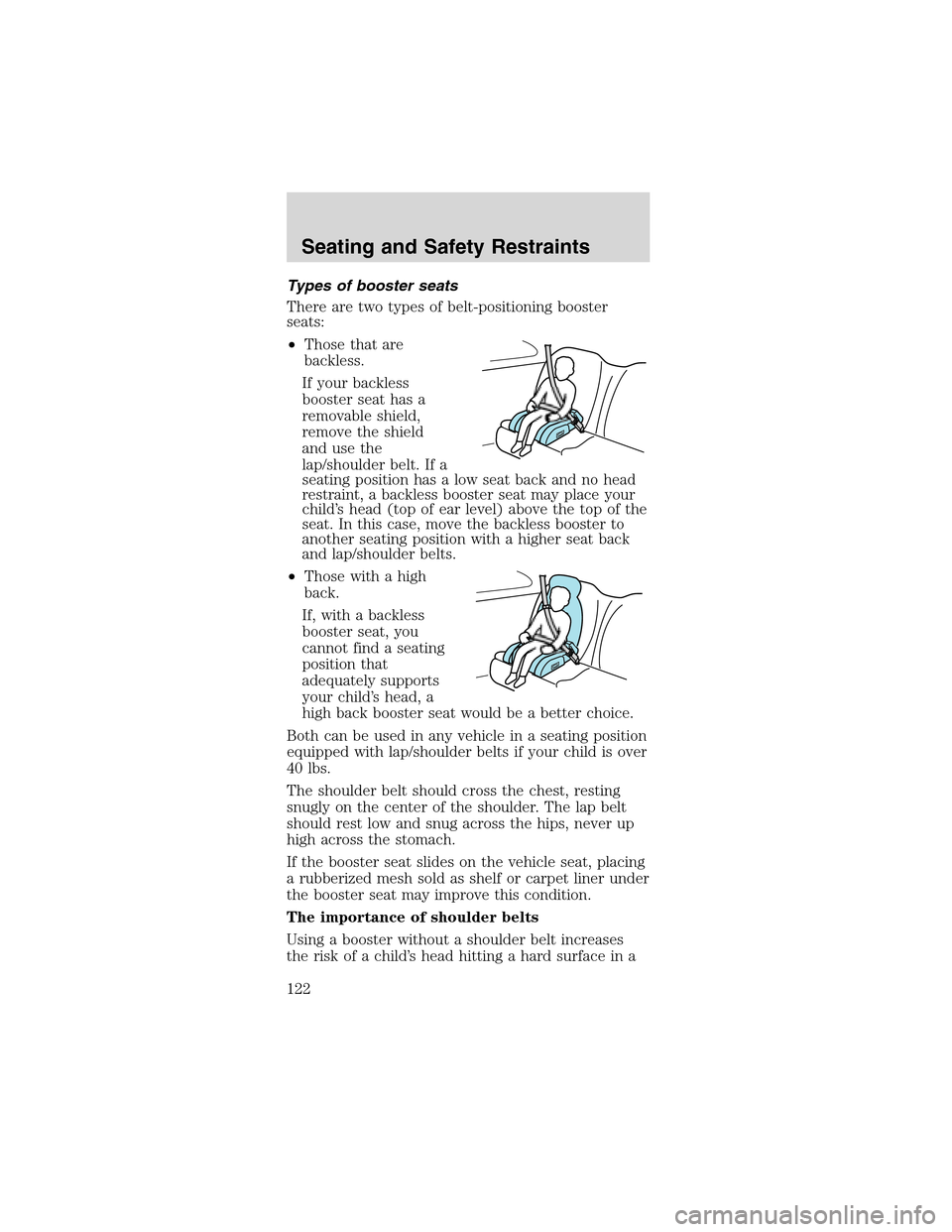
Types of booster seats
There are two types of belt-positioning booster
seats:
•Those that are
backless.
If your backless
booster seat has a
removable shield,
remove the shield
and use the
lap/shoulder belt. If a
seating position has a low seat back and no head
restraint, a backless booster seat may place your
child’s head (top of ear level) above the top of the
seat. In this case, move the backless booster to
another seating position with a higher seat back
and lap/shoulder belts.
•Those with a high
back.
If, with a backless
booster seat, you
cannot find a seating
position that
adequately supports
your child’s head, a
high back booster seat would be a better choice.
Both can be used in any vehicle in a seating position
equipped with lap/shoulder belts if your child is over
40 lbs.
The shoulder belt should cross the chest, resting
snugly on the center of the shoulder. The lap belt
should rest low and snug across the hips, never up
high across the stomach.
If the booster seat slides on the vehicle seat, placing
a rubberized mesh sold as shelf or carpet liner under
the booster seat may improve this condition.
The importance of shoulder belts
Using a booster without a shoulder belt increases
the risk of a child’s head hitting a hard surface in a
Seating and Safety Restraints
122
Page 127 of 256
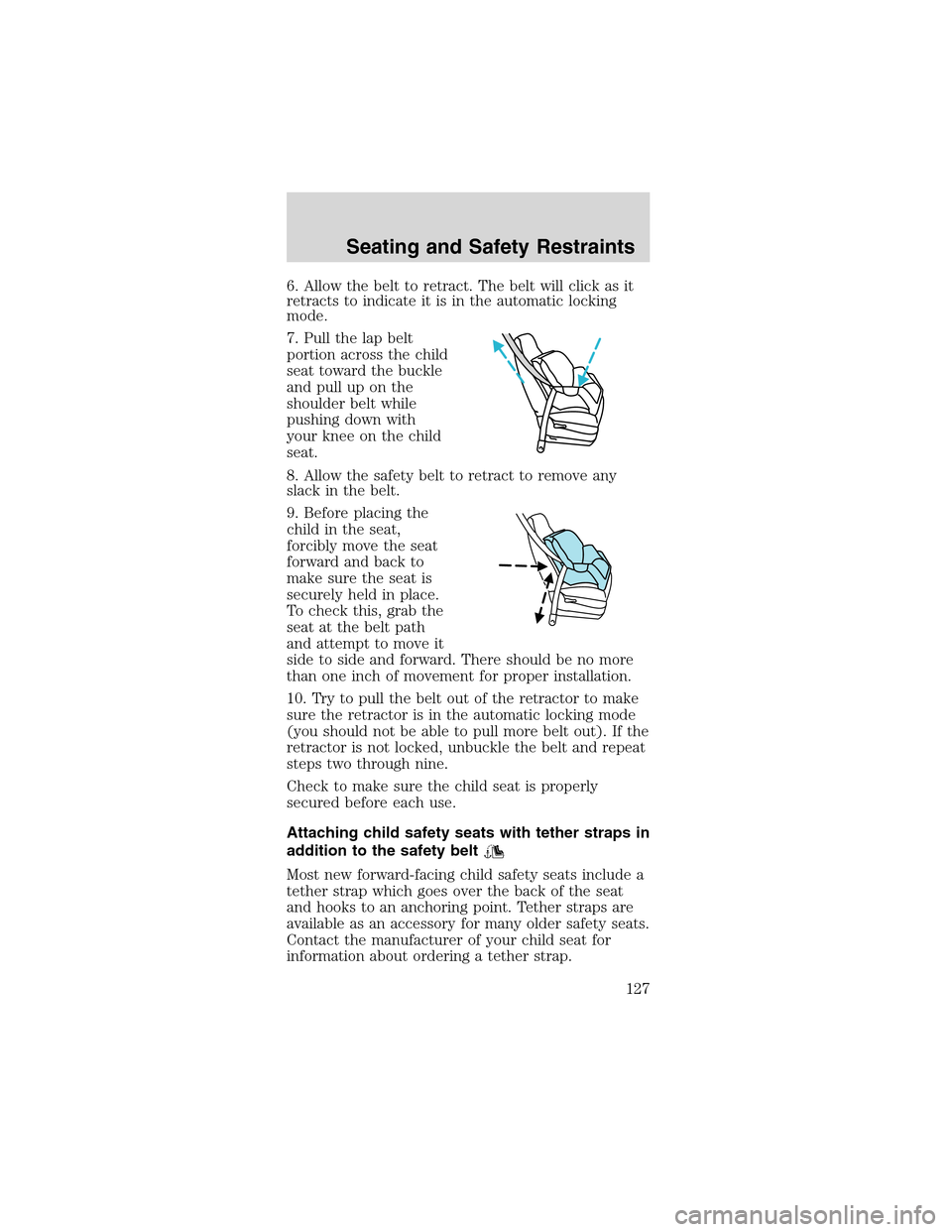
6. Allow the belt to retract. The belt will click as it
retracts to indicate it is in the automatic locking
mode.
7. Pull the lap belt
portion across the child
seat toward the buckle
and pull up on the
shoulder belt while
pushing down with
your knee on the child
seat.
8. Allow the safety belt to retract to remove any
slack in the belt.
9. Before placing the
child in the seat,
forcibly move the seat
forward and back to
make sure the seat is
securely held in place.
To check this, grab the
seat at the belt path
and attempt to move it
side to side and forward. There should be no more
than one inch of movement for proper installation.
10. Try to pull the belt out of the retractor to make
sure the retractor is in the automatic locking mode
(you should not be able to pull more belt out). If the
retractor is not locked, unbuckle the belt and repeat
steps two through nine.
Check to make sure the child seat is properly
secured before each use.
Attaching child safety seats with tether straps in
addition to the safety belt
Most new forward-facing child safety seats include a
tether strap which goes over the back of the seat
and hooks to an anchoring point. Tether straps are
available as an accessory for many older safety seats.
Contact the manufacturer of your child seat for
information about ordering a tether strap.
Seating and Safety Restraints
127
Page 191 of 256
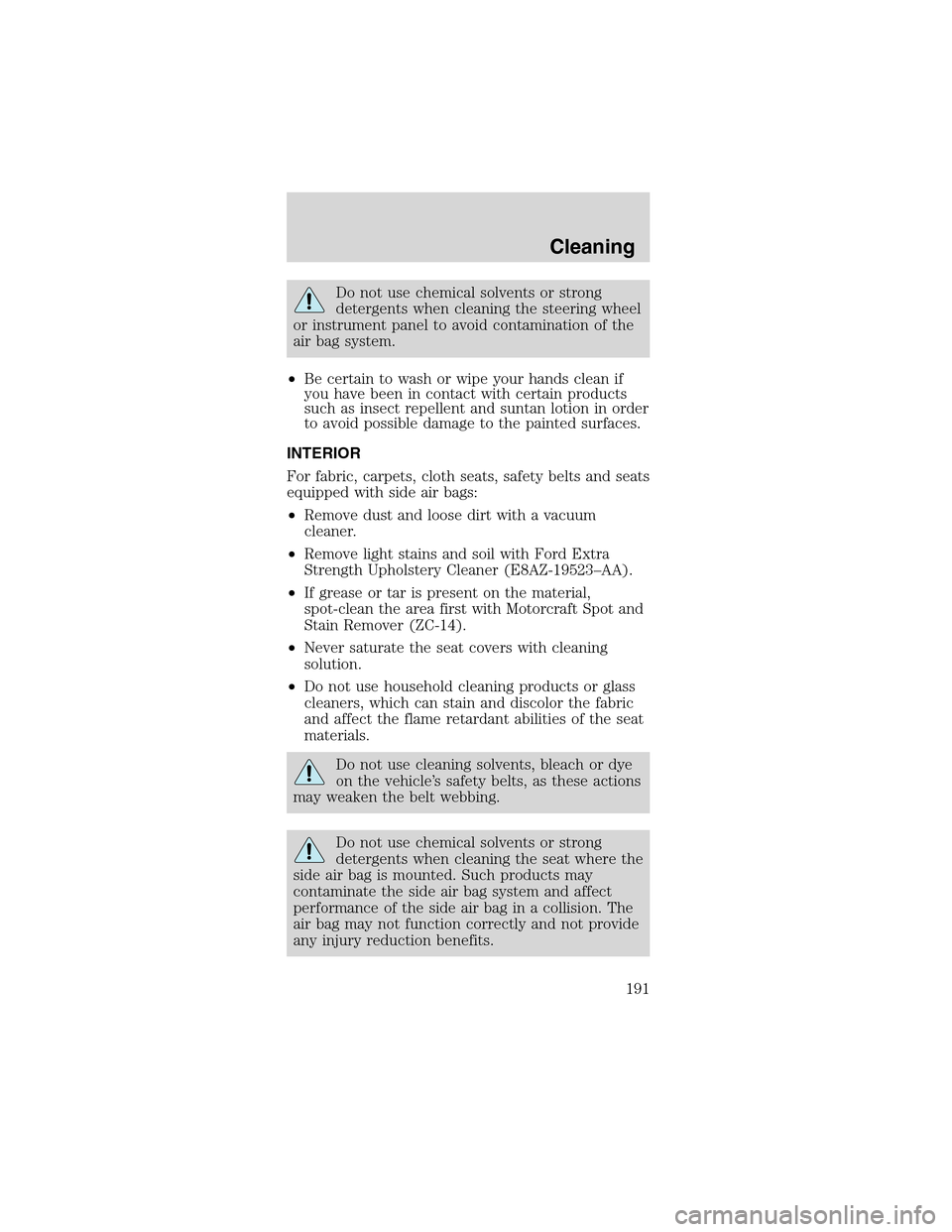
Do not use chemical solvents or strong
detergents when cleaning the steering wheel
or instrument panel to avoid contamination of the
air bag system.
•Be certain to wash or wipe your hands clean if
you have been in contact with certain products
such as insect repellent and suntan lotion in order
to avoid possible damage to the painted surfaces.
INTERIOR
For fabric, carpets, cloth seats, safety belts and seats
equipped with side air bags:
•Remove dust and loose dirt with a vacuum
cleaner.
•Remove light stains and soil with Ford Extra
Strength Upholstery Cleaner (E8AZ-19523–AA).
•If grease or tar is present on the material,
spot-clean the area first with Motorcraft Spot and
Stain Remover (ZC-14).
•Never saturate the seat covers with cleaning
solution.
•Do not use household cleaning products or glass
cleaners, which can stain and discolor the fabric
and affect the flame retardant abilities of the seat
materials.
Do not use cleaning solvents, bleach or dye
on the vehicle’s safety belts, as these actions
may weaken the belt webbing.
Do not use chemical solvents or strong
detergents when cleaning the seat where the
side air bag is mounted. Such products may
contaminate the side air bag system and affect
performance of the side air bag in a collision. The
air bag may not function correctly and not provide
any injury reduction benefits.
Cleaning
191